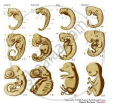Advertisements
Advertisements
प्रश्न
Observe the following images and answer the questions.

- Which evolutionary evidences are indicated in the given picture?
- How are they formed?
- Which method is used to measure their age or their time?
उत्तर
- The given pictures indicate paleontological evidences of evolution.
- Large number of organisms get buried due to disasters like flood, earthquake, volcano, etc. Remnants and impressions of such organisms remain preserved underground and form fossils.
- Carbon dating is a method used to measure the age of fossils.
APPEARS IN
संबंधित प्रश्न
“Two areas of study namely 'evolution' and 'classification' are interlinked'. Justify this statement.
Which of the following is a correct set of homologous organs?
(a) Forelimbs of frog, bird and lizard
(b) Spine of cactus and thorn of bougainvillea
(c) Wings of bat and wings of butterfly
(d) Wings of a bird and wings of a bat
Four students A, B, C and D reported the following set of organs to be homologous. Who is correct ?
(A) Wings of a bat and a butterfly
(B) Wings of a pigeon and a bat
(C) Wings of a pigeon and a butterfly
(D) Forelimbs of cow, a duck and a lizard
Explain the evolution of giraffe's neck according to Lamarck's theory of evolution.
Name any two temporary embryonic structures in vertebrates which provide evidence for evolution.
What are homologous organs?
Human tailbone is a vestigial organ. Explain.
Differentiate between analogous and homologous structures.
Select and write analogous structures from the list given below :
1) Wings of butterfly and birds
2) Vertebrate hearts
3) Tendrils of Bougainvillea and Cucurbita
4) Tubers of sweet potato and potato
Out of bacteria, spider, fish and chimpanzee, which organism has a better body design in evolutionary terms? Give reason for your answer.
The wings of a housefly and the wings of a sparrow are an example of :
(a) analogous organs
(b) vestigial organs
(c) respiratory organs
(d) homologous organs
Identify the following pairs as homologous and analogous organs:
(i) Sweet potato and potato
(ii) Eye of octopus and eye of mammals
(iii) Thorns of Bougainvillaea and tendrils of Cucurbits
(iv) Fore limbs of bat and whale
Select a set of homologous organs from the following:
(A) Wings of a bat and wings of a butterfly
(B) Wings of a pigeon and wings of a bat
(C) Wings of a butterfly and wings of a pigeon
(D) Forelimbs of a duck, forelimbs of a cow and forelimbs of a lizard
Write the names of those animals in whom the human body organs are functioning.
Explain with suitable examples importance of anatomical evidence in evolution.
Observe the picture and answer the following questions.
A) Which evidence of evolution is shown in the picture?
B) What can be proven with this proof?
C) Give one more example of evidence of evolution
What do you mean by vestigial structures? Name four vestigial organs found in man.
Answer the following question:
What are homologous structures? Give an example. Is it necessary that homologous structures always have a common ancestor? Justify your answer.
Very short answer question.
What are homologous organs?
Very short answer question:
What is vestigeal organ?
Find an odd one out.
Find an odd one out.
Name the parts shown in the diagram.
Human jaw

Give scientific reason.
Duck-billed platypus shows relationship with mammals.
Which evidence of evolution is shown in the given picture? Explain the importance of this evidence.

Select the correct statement.
Cucurbits do not develop thick and woody stem as they are:
The bones of forelimbs of whale, bat, cheetah and man are similar in structure, because ______.
Appearance of antibiotic-resistant bacteria is an example of ______.
Did aquatic life forms get fossilised? If, yes where do we come across such fossils?
What are we referring to? When we say 'simple organisms' or 'complex organisms'.
How do we compute the age of a rock?
Find odd one out:
Write down the difference between homologous and analogous organs.
Find the odd one out:
Write a note on the significance of Palaeontology.
Pick the odd man out:
